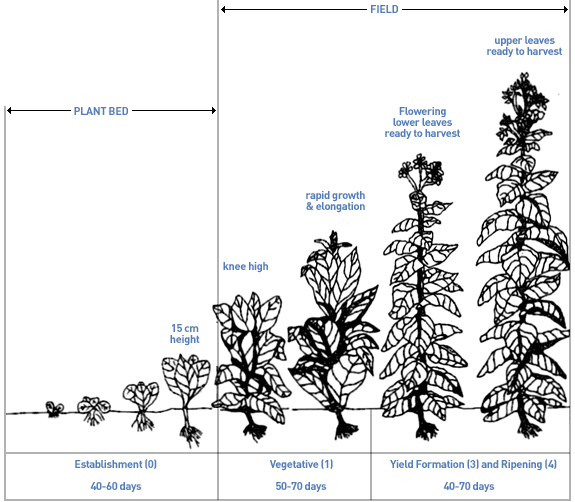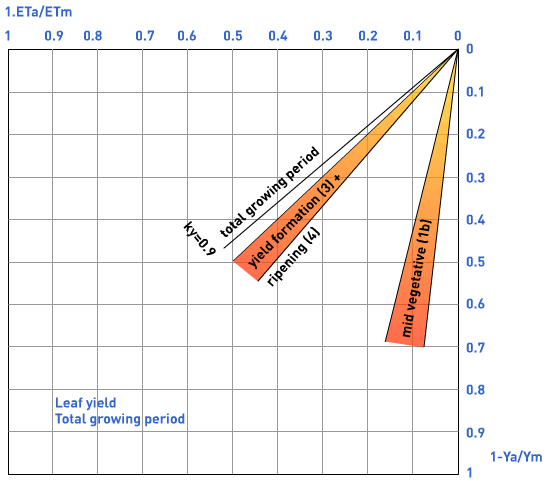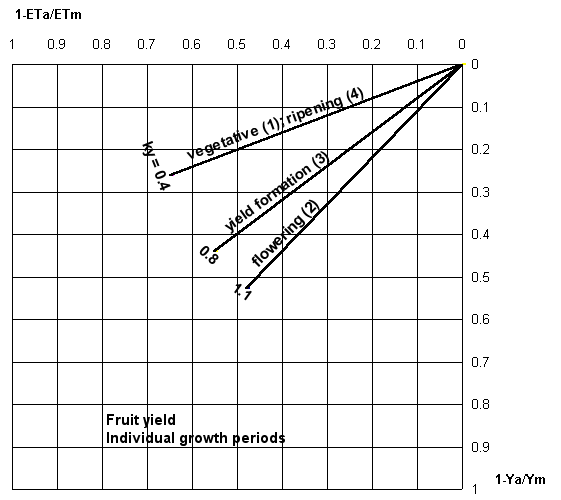Tobacco
This section presents information on water relations and water management of tobacco and provides links to other sources of information.
Crop Description and Climate
Crop Description and Climate
Tobacco (Nicotiana tabacum) is believed to have originated from South America. Present world production is about 6.3 million tons of leaves from 4.2 million ha. (FAOSTAT, 2001).
The crop can be broadly divided according to the method of curing the leaves flue, fire, air or sun-cured. In general, the dark-coloured air and fire-cured tobacco is used for pipe and cigar tobacco, whereas the light-coloured flue and sun-cured is used for cigarette tobacco.
Tobacco is grown under a wide range of climates but requires a frost-free period of 90 to 120 days from transplanting to last harvest of leaves. Optimum mean daily temperature for growth is between 20 and 30°C. A dry period is required for ripening and harvest of the leaves. Excess rainfall results in thin, lightweight leaves. Sun-cured or oriental tobacco requires a relatively dry climate to develop its full aroma. Except for some short-day varieties, cultivated tobacco is day-neutral in its response to flowering.
A light, sandy soil is required for flue-cured, light tobacco. Air-cured, dark tobacco is grown on silty loam to clay loam soils, while fire-cured and air-cured, light tobacco is mostly grown on medium textured soils. The crop is sensitive to waterlogging and demands well-aerated and drained soils. The optimum pH ranges from 5 to 6.5. Quality of the leaves is affected by soil salinity. Depending on the type of tobacco, fertilizer requirements vary and in general are 40 to 80 kg/ha N, 30 to 90 kg/ha P and 50 to 110 kg/ha K.
Tobacco is sown on seed beds and is transplanted 40 to 60 days after sowing when the plants are about 15cm tall. During the first weeks the seedbeds are often covered to protect the young seedlings against unfavourable weather. Spacing after transplantation caries with variety and is generally between 1.2 to 0.9 x 0.9 to 0.6 m. Crop rotation after one or two seasons is recommended with crops such as grass, sorghum, millet and maize that are not susceptible to root eelworm.
To produce high value leaves, topping (removal of flower buds) and desuckering (removal of side shoots) is often practised. Time and height of topping depends on the type of tobacco but is usúal1y done when 10 percent of the plants have their buds in flower.
Stages of Development | Plant date | Region | |||||
|---|---|---|---|---|---|---|---|
Crop characteristic | Initial | Crop Development | Mid-season | Late | Total | ||
Stage length, days | 20 | 30 | 30 | 30 | 110 | ||
Depletion Coefficient, p | 0.4 | >> | 0.5 | 0.65 | - | ||
Root Depth, m | 0.25 | >> | >> | 0.8 | - | ||
Crop Coefficient, Kc | 0.5 | >> | 1.1 | 0.8 | - | ||
Yield Response Factor, Ky | 0.2 | 1.0 | 0.5 | 0.5 | 0.9 | ||
Water Requirements
Water Requirements
The water requirements (ETm) for maximum yield vary with climate and length of growing period from 400 to 600mm. During the first weeks after emergence in the seedbed the seedlings require 3 to 5 litres/m2 daily. After 30 to 40 days the seedlings receive less water so as to obtain a more robust plant. After 40 to 60 days, the seedlings are transplanted and the crop is harvested 90 to 120 days after transplanting. The period of maximum water requirements occurs 50 to 70 days after transplanting and is followed by a decrease in water requirements.
The crop coefficient (kc) relating crop water requirements (ETm) to reference evapotranspiration (ETo) for the different development stages after transplanting are: during the initial stage 0.3-0.4 (10 days), the development stage 0.7-0.8 (20 to 30 days), the mid-season stage 1.0-1.2 (30 to 35 days), during the late-season stage 0.9-1.0 (30 to 40 days) and at harvest 0. 75-0.85.
Water Supply And Crop Yield
Following figure shows growth period in tobacco (Lucas)

The relationships between relative yield decrease (1 - Ya/Ym) and relative evapotranspiration deficit for the total growing period are shown in the figure below

This figure shows the relationships between relative yield decrease (1 - Ya/Ym) and relative evapotranspiration deficit for the individual growth periods.

The water regimes from which a full crop of tobacco can be obtained vary from stored soil water, rainfall, supplemental irrigation or full irrigation. Careful water scheduling is required because too frequent irrigation damages the crop. Water deficits in certain periods may increase yields and it is recommended practice to subject seedlings during the establishment period (0) prior to transplanting to a period of moderate water deficit to increase their drought resistance. Also, moderate water deficits during the early vegetative period (1a) may enhance root development. Moderate water deficits during the first 20 to 30 days after transplanting have little effect on final yield but cause temporary retarded growth; however, the crop recovers rapidly with subsequent irrigations. In most cases, final yields may be larger compared to a crop receiving full irrigation throughout this growth period (1a).
Water deficits during the mid-vegetative period (rapid growth, 1b) result in reduced growth and smaller leaves. Severe water deficits during the yield formation and ripening periods (3 and 4) affect leaf weight and chemical composition which in turn affects the fire-holding capacity. However, a mild water deficit during ripening (4) is desirable to restrict growth of new young leaves.
Excess water results in leaves of low quality. Heavy rain or irrigation may cause 'wilting', 'wet feet' or 'drowning'. Waterlogging for two or more days generally severely damages the crop and may kill the plants.
To obtain maximum total production under limited water supply, management should be directed towards increasing the area and partially meeting the crop water requirements rather than meeting full crop water requirements over a limited area.
Water Uptake
Water Uptake
Tobacco has a well-developed tap root with extensive horizontal lateral roots. Normally 75 percent of the water uptake occurs over the first 0.3m.and 100 percent over the first 0.5 to 1.0 m (D = 0.5-1.0 m). Root development is enhanced by withholding water supply during early vegetative period (1a). Also topping and desuckering will favour root development. Full rooting depth is reached some 40 to 50 days after transplanting. Under conditions when ETm is 5 to 6mm/day, water uptake will be affected when 50 to 60 percent of the total available soil water has been depleted (p = o.6).
Irrigation Scheduling
Irrigation Scheduling
Water must be supplied daily to the young seedlings in the seedbed (0) even when evapotranspiration is moderate. At the end of the seedbed period (0) water is withheld for a few days. Immediately before and during transplanting water is supplied to the plants individually to help them through the first weeks after transplanting. During the rapid growth period (1b), water should be supplied frequently. During the early yield formation period (3), at flowering, few deep irrigations may be sufficient to obtain optimum yields of high quality. When water is limited, water should be applied at transplanting, during the period of rapid growth (1b), and during the early yield formation period (3).
Irrigation Methods
Surface and sprinkler irrigation are mostly practised. The quality of the water is important in selecting the most suitable irrigation method, e.g. sprinkler irrigation should be avoided when only low quality water is available.
Yield
Yield
Normally 18 to 22 leaves are harvested with 2 to 3 leaves per week for 30 to 50 days. Occasionally, when half the leaves have been harvested and if the remaining leaves show a uniform ripening, the whole plant is harvested, thus saving labour. Good yields under commercial production with adequate water supply are in the range of 2 to 2.5 ton/ha of leaves. The water utilization efficiency for harvested yield (Ey) for cured leaves containing about 10 percent moisture is 0.4 to 0.6 kg/m3.
Irrigation practices together with cultivation practices, e.g. topping, and soil fertility affect leaf quality. Nicotine content of the leaf is generally 1.5 to 2.5 percent of dry leaf matter for the flue-cured tobacco and 3 to 4 percent for the air-cured tobacco. Tobacco grown under dry conditions frequently has a dark, small leaf which is dull in colour and lacks elasticity. However, it has a high nicotine content. Under adequate water supply the leaves are thinner and more elastic, and also the colour is improved, while the nicotine content is optimal. Over-irrigation, particularly during the latter part of the total growing period results in inferior leaf quality.

